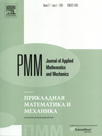 | | Journal of Applied
Mathematics and Mechanics
Russian Academy of Sciences | | Founded
in January 1936
(Translated from 1958)
Issued 6 times a year
ISSN 0021-8928
(print version) |
Archive of Issues
| Total articles in the database: | | 10610 |
| In Russian (¤╠╠): | | 9811
|
| In English (J. Appl. Math. Mech.): | | 799 |
|
| << Previous article | Volume 78, Issue 4 / 2014 | Next article >> |
| A.N. Kraiko, K.S. Pĺyankov, and Ye.A. Yakovlev, "The flow of a supersonic ideal gas with "weak" and "strong" shocks over a wedge," J. Appl. Math. Mech. 78 (4), 318-330 (2014) |
| Year |
2014 |
Volume |
78 |
Issue |
4 |
Pages |
318-330 |
| Title |
The flow of a supersonic ideal gas with "weak" and "strong" shocks over a wedge |
| Author(s) |
A.N. Kraiko (Moscow, Russia, akraiko@ciam.ru)
K.S. Pĺyankov (Moscow, Russia)
Ye.A. Yakovlev (Moscow, Russia) |
| Abstract |
The problem of the flow of a uniform supersonic ideal (inviscid and non-heat-conducting) gas over a wedge is considered. If the turning angle of the flow, which is equal to the angle of inclination of the generatrix of the wedge, is less than the maximum value, the problem has two solutions. In the solution with an oblique low-intensity ("weak") shock, the uniform flow between the shock and the wedge is almost always supersonic. One exception is a small vicinity of the maximum turning angle. For an ideal gas this vicinity does not exceed a fraction of a degree at all Mach numbers. Behind a high-intensity ("strong") shock, the flow of an ideal gas is always subsonic. "Weak" shocks are observed in all experiments with finite wedges. Some researchers attribute this preference to the "downstream" boundary conditions ("on the right at infinity" for a flow incident on the wedge from the left), and others attribute it to the instability ("Lyapunov" instability) of a flow with a strong shock when it flows over the wedge and to the stability of flow with a weak shock. The results presented below from calculations of the flows that occur for finite wedges within the two-dimensional unsteady Euler equations, when the parameters behind the strong shock are specified on the right-hand boundary, i.e., on the arc of a circle between the wedge and the shock, demonstrate the correctness of the conclusion of the first group of researchers and the incorrectness of the conclusion of the other group. In these calculations, after both small and fairly large perturbations, the flows investigated (which are, in fact, Lyapunov unstable!) return to the solution with a strong shock. In addition, the problem of steady flow over a wedge was regarded as the limit of the two-dimensional non-steady problems at infinite time. Simplification of one of them leads to the problem of the submerged over-expanded supersonic steady outflow. In the ideal gas model this problem is equivalent to flow over a wedge with both weak and strong shocks. All the solutions considered are stable. |
| Received |
17 March 2014 |
| Link to Fulltext |
|
| << Previous article | Volume 78, Issue 4 / 2014 | Next article >> |
|
 If you find a misprint on a webpage, please help us correct it promptly - just highlight and press Ctrl+Enter If you find a misprint on a webpage, please help us correct it promptly - just highlight and press Ctrl+Enter
|
|

 Russian
Russian  English
English